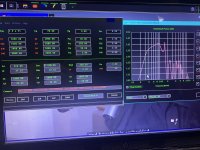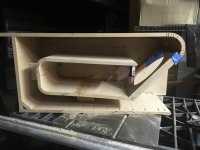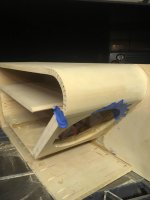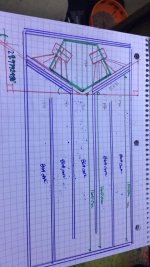So TH looks like a special case of BP6S, when you basically the front chamber and the front port has the same cross section area and the second chamber has no port or you can say the port also has the same cross section area of the chamber but the length is 0.
What will really blow your mind is that IMO a TH can be considered a BP6S with a very poor out of band noise response 🙂. Its major advantage is the large "vent" significantly reduces compression effects at high SPL levels. I measured only 0.3dB of compression for my POC3 when distortion was hitting 10% within the passband. My POC6 MLTL with its 0.67*Sd sized vent was hitting 1.5~2dB of compression at the same THD. With smaller vents, the compression effect will be even higher.
That alignment actually looks a bit undersized. Increase the CSA of the TL and that should increase the gain around Fb, flattening the response down to Fb.I apologize planet10!
TH, BP6S, and ODTL are the SAME!
Brian Steele is right, ODTL is the way to go when it comes to speaker mounting and modeling.
I think the TH and BP6S will sound better since the speaker is hidden in the enclosure.
TH and BP6S have better speaker protection.
View attachment 1129860
This is something I probably wouldn't build though because of that massive cancellation @100 Hz, but if you're looking for pure SPL (i.e. a "bass whistle"), this would be the way to go... 🙂
Ok...take 234Probably 8th order bandpass 🙂
Seriously, there's usually more conditions involved than peak SPL when choosing a design. Portability, for one.
what is the design that squeeze up to the last drop of SPL. For any given driver.with the most portability.
Your 4 skar ddx box (aligned) free of the phase discontinuity issue in paraflex models’ .
This is loud and wide by any measure. (I just used 15mm excursion to limit this for example) . it’s ~36” long and ~16” tall…. and wide …
so split into two boxes or Whatever ‘portable’ needs to be. But there’s ‘better’ drivers than that skar? It’s only $145 shipped in USA so it’s hard to argue for making ‘spl‘ noise 😀
This is loud and wide by any measure. (I just used 15mm excursion to limit this for example) . it’s ~36” long and ~16” tall…. and wide …
so split into two boxes or Whatever ‘portable’ needs to be. But there’s ‘better’ drivers than that skar? It’s only $145 shipped in USA so it’s hard to argue for making ‘spl‘ noise 😀
Attachments
Last edited:
My 'knee-jerk' response is BP4, i.e. horn compression driver.Ok let me rephrase , what is the design that squeeze up to the last drop of SPL. For any given driver.
Some questions , I read somewhere that the sensitivity don't matter much for some designs (can't remember ) so the skar ddx12 is rated at 88db sensitivity , it's ok?Your 4 skar ddx box (aligned) free of the phase discontinuity issue in paraflex models’ .
This is loud and wide by any measure. (I just used 15mm excursion to limit this for example) . it’s ~36” long and ~16” tall…. and wide …
so split into two boxes or Whatever ‘portable’ needs to be. But there’s ‘better’ drivers than that skar? It’s only $145 shipped in USA so it’s hard to argue for making ‘spl‘ noise 😀
What you mean by aligned? To tweak the driver position or change dimensions ?
For the best compromise, I think the best type for PA use is probably the tapped-horn (TH). Size is larger than sealed or vented, but "portability" is more about just size - form factor is also important, and a TH can be designed to be a rectangular box that you can tip and wheel around, making it easier to move.
THs also have another advantage - the driver is not fully enclosed in the cabinet (but enclosed enough to reduce physical damage from an errant hand or foot), and it's located in the mouth, which likely improves heat dissipation at high volume levels (e.g. at Fb, when coil movement is at a minimum and the coil is dissipating the most heat, air movement in the mouth is at a maximum). The mouth of the TH is also large enough to significantly reduce compression effects at high power levels. Disadvantage? Usually bandwidth-limited to below 100 Hz, integration with tops might be a bit of a challenge if you don't have decent DSP, and best used with drivers that don't suffer from motor noise.
THs also have another advantage - the driver is not fully enclosed in the cabinet (but enclosed enough to reduce physical damage from an errant hand or foot), and it's located in the mouth, which likely improves heat dissipation at high volume levels (e.g. at Fb, when coil movement is at a minimum and the coil is dissipating the most heat, air movement in the mouth is at a maximum). The mouth of the TH is also large enough to significantly reduce compression effects at high power levels. Disadvantage? Usually bandwidth-limited to below 100 Hz, integration with tops might be a bit of a challenge if you don't have decent DSP, and best used with drivers that don't suffer from motor noise.
no more upper bandwidth 💩💩
It be careful of the port sizing….as mentioned
It be careful of the port sizing….as mentioned
Attachments
10-4For the best compromise, I think the best type for PA use is probably the tapped-horn (TH). Size is larger than sealed or vented, but "portability" is more about just size - form factor is also important, and a TH can be designed to be a rectangular box that you can tip and wheel around, making it easier to move.
THs also have another advantage - the driver is not fully enclosed in the cabinet (but enclosed enough to reduce physical damage from an errant hand or foot), and it's located in the mouth, which likely improves heat dissipation at high volume levels (e.g. at Fb, when coil movement is at a minimum and the coil is dissipating the most heat, air movement in the mouth is at a maximum). The mouth of the TH is also large enough to significantly reduce compression effects at high power levels. Disadvantage? Usually bandwidth-limited to below 100 Hz, integration with tops might be a bit of a challenge if you don't have decent DSP, and best used with drivers that don't suffer from motor noise.
A driverack PA qualify as decent DSP? Or you need a venu360 or BSS processor
Hey that's dope!!no more upper bandwidth 💩💩
It be careful of the port sizing….as mentioned
How do you bend the plywood 😮😮
Blow up the picture to see all the closely spaced kerf/slit cuts, then normally use steam to hand/whatever form, though not sure if that's wise if MDF (no experience).
Curious also since I'm a long time fan/early adopter of dbx electronics, though Rick McInnis chose to use whatever brand DSL uses for their speaker systems for his DIY MEH system.A driverack PA qualify as decent DSP? Or you need a venu360 or BSS processor
Some questions , I read somewhere that the sensitivity don't matter much for some designs (can't remember ) so the skar ddx12 is rated at 88db sensitivity , it's ok?
From my point of view, this s not true.
Sensitivity always matter.
peak SPL when choosing a design. Portability
Brian point other important things about choosing a /box/driver design and the peak SPL is the most important one related to sensitivity.
I suggest o to check amplifier constrain when people ask for a comment, because if you are Voltage constrained, for a PA, you need to extract as much SPL as possible from that voltage and this means that with light weight cone driver and Higher order box design you can achiever higher SPL level, very simple.
If an Audio Company needs a kind of "peak power density", I mean, as much SPL as possible from a given volume, and voltage isn't a constrain because they can buy the most expensive amplifier at any quantity, power supply is not limited too, so increasing peak power will damage light weight cone, because they do not have enough resistance to mechanically resist sound pressure at war level, in this case you need to move to B&C and other reinforced cones, the reinforcement will reduce the sensitivity but it allow you to achieve higher SPL level and survive for long term, you need to make money. Less box to assembly/carry and less cost with transport.
So, always prefer higher sensitivity driver unless the peak pressure isn't an issue for the cone, but you can always adjust he box design to reduce pressure over cone.
Other then voltage constrain, sometimes can be limited from power suppler constrain. How much SPL you can achieve with a subwoofer at 40Hz from a power supply of 10A and 115V ? (1150 Watts - Electrical)
Probably the answer is:
you need a Class D amplifier + High sensitivity driver + high order box.
Compare with
Class AB amplifier + low sensitivity driver + Bass Reflex
1200W @2ohms per channel (2 channels)
Class D
So in my case 3 units of 3015LF per channel or just 2 per channel
That meana 3 cabinets per amp channel or 2
Per channel depending to what voltage I will limit the 3015LF
So I need to get the most SPL of that modest power source.
Class D
So in my case 3 units of 3015LF per channel or just 2 per channel
That meana 3 cabinets per amp channel or 2
Per channel depending to what voltage I will limit the 3015LF
So I need to get the most SPL of that modest power source.
Last edited by a moderator:
BSS are hell expensive , there is another brand i don't recall now that have FIR processing but almost all pro brands (nexo,Meyer,RCF,Adamson,HK audio,dB technologies,DSL ) to name a few have their own branded processors.Curious also since I'm a long time fan/early adopter of dbx electronics, though Rick McInnis chose to use whatever brand DSL uses for their speaker systems for his DIY MEH system.
There is guys that swear by the Ashley protea processors.
Thing is that according to some lab tests the more expensive units have superior AD/DA chipsets with oversampling and a lot of mumbo jumbo digital tech plus discreet analog stages with premium caps and resistors (audiophile grade) plus the FIR processing and related high end filtering.
And again if I got the money to get that...why bother to make my own if I can get 8 touring racks loaded with state of the art FIR and lab gruppen latest digital amps with 40 linear cabinets per side and 30 subs per side. From MEYER
Ohhhh those wet dreams.
So waking up and realizing that I can only afford a couple of 3015LF's and a driverack PA
And some substandard not void free grade b plywood
I need to learn much as I can to DIY and INsource man-hours/design R&D to coax out some decent noise from some franken cabinets.
1200W @2ohms per channel (2 channels)
Class D
So in my case 3 units of 3015LF per channel or just 2 per channel
That meana 3 cabinets per amp channel or 2
Per channel depending to what voltage I will limit the 3015LF
So I need to get the most SPL of that modest power source.
First, you need to choose the box design, learn how to model in hornresp, check your amplifier max voltage output for each impedance, in general the max voltage reduces if you lower the impedance because the current will increase, if it don't indicate the max voltage, you can estimate it based on your max power output for as specific impedance. So you will use two voltages in the simulation with hornresp:
Pay attention regarding the standard the OEM used to specify the power, in general Class D indicate max peak power per channel, while Class AB indicates Max power output for senoidal signal (3dB crest Factor) so peak max output needs to be multiplied for 2.
2,83V for 8ohm driver and the second value according to your amplifier max output voltage for 8ohm impedance. You should compare driver+box options under those two conditions for a practical purpose.
i have an RMS volt meter, how can i measure my max voltage before clipping on my amp? i mean how to simulate 4 or 2 ohm load....
mmmm... you know what
i can actually do the test with actual speaker loads, i have 4 LX18's that i can connect to a channel and see whats my voltage reading @60hz sinewave
that btw that are the designed freq for voltage meter to check the mains electrical lines
i know that manufacturers says my XYZ amp can do 1 ohm load with 12KW watts,
but i will test mine to see how much voltage can actually coax out and with how many drivers in parallel.
now, 60hz sinewave ? or what signal to test the Voltage out at the speaker teminals of the amp.
also where i can read on how to measure the impedance on the cabinets
as once i start building my 1st cabinet i will do the Freq chart and impedance chart with REW
i am starting to assimilate the audio speaker jargon 😀
🙂
as i want to share with the community the hornresp predicted simulations VS the real world measurements
below is the manufacturer published specs for the amp, but i do not trust it 100 as the internals are kind of scarce compared to the powersoft or labgrupen look alikes.


VS
the look alikes


mmmm... you know what
i can actually do the test with actual speaker loads, i have 4 LX18's that i can connect to a channel and see whats my voltage reading @60hz sinewave
that btw that are the designed freq for voltage meter to check the mains electrical lines
i know that manufacturers says my XYZ amp can do 1 ohm load with 12KW watts,
but i will test mine to see how much voltage can actually coax out and with how many drivers in parallel.
now, 60hz sinewave ? or what signal to test the Voltage out at the speaker teminals of the amp.
also where i can read on how to measure the impedance on the cabinets
as once i start building my 1st cabinet i will do the Freq chart and impedance chart with REW
i am starting to assimilate the audio speaker jargon 😀
🙂
as i want to share with the community the hornresp predicted simulations VS the real world measurements
below is the manufacturer published specs for the amp, but i do not trust it 100 as the internals are kind of scarce compared to the powersoft or labgrupen look alikes.
VS
the look alikes
Last edited:
we are deviating too much from the original post.
This is not simple as you think mainly because of Burst signal, the the amount of time a peak power is sustained is very short. While class AB is simple to measure it using a multimeter/voltmeter, Class D is a bit more complicate.
It's safer to trust in the datasheet indication with some margin at lower impedance, but 8ohn is OK.
This is not simple as you think mainly because of Burst signal, the the amount of time a peak power is sustained is very short. While class AB is simple to measure it using a multimeter/voltmeter, Class D is a bit more complicate.
It's safer to trust in the datasheet indication with some margin at lower impedance, but 8ohn is OK.
Voltage@2ohm = sqrt(1200*2) =49,0V
Voltage@4ohm = sqrt(775*4) = 55,7V
Voltage@8ohm = sqrt(440*8) = 59,3V
- Home
- Loudspeakers
- Subwoofers
- Big, big TL...




